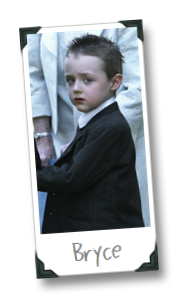
Our lives changed forever after that day. Everyday was going to be a new learning experience. Even something as simple as walking up the stairs was a task for Bryce. He couldn’t grasp the concept of walking one foot after the other up the stairs and would step up with both feet on one stair. Daniel had to physically grab Bryce’s ankles and motion his feet where they had to go, over and over again, for Bryce to realize that he could walk up the stairs one foot after the other.
The first thing we did was literally Google’d ‘What is autism?’ so that we could understand it a bit more. I’ll tell you right now though that their is no amount of knowledge in the world that can get you ready for being a parent of a child with autism. You literally have to learn each day by day because everyday is different.
So after educating ourselves, we learned that the British Columbia Provincial Government had an autism funding program to financially support families with the costs of early intervention treatment. Initially the $20,000 a year, paid out monthly, seemed impressive, but we soon found out the true costs of an early intervention treatment program.
The government program required us to independently interview and hire a Behavioural Consultant to develop an intervention plan. Then we have to hire a Behavioural Interventionist, who is trained by the Behavioural Consultant, to implement the plan. At the time, there was no formal training or certification to become a Behavioural Consultant so we relied on a reference list from the government website and a reference list from ACT BC’s website. More than half of the Behavioural Consultants we contacted quoted us for more than the $1,667 provided per month by the government to develop, manage the Behavioural Interventionists and revise the plan as Bryce progressed. That spent our entire funding without a single hour of treatment in a month!
Bryce was still in the Infant Development Program provided by the city, and had a Supported Childcare Consultant provided by the city, and we were recommended a Behavioural Consultant that had worked with other families in those programs. We found one that would cost us a little over half the funding to meet the program requirements to receive the autism funding. The other half of the autism funding we spent on a daily Behaviour Interventionist, split between two of the commonly recognized Early Intervention treatments for autism. First we went with an ABA program that could teach Bryce the fundamental aspects, and mechanics of the day to day skills he would need. These were activities like colors, numbers, letters, shapes, identifying food and dangers, etc. The other treatment, which we discovered and researched through seminars provided by ACTBC, was DIR/Floortime. The interventionists instead worked on the social and interactive dynamics in a structured approach. Instead of learning repetitive skills he learned how to participate in activities that involved communication, sharing, and appropriate social behaviours.
Daniel’s work group plan insurance covered a small portion of costs, and allowed us to have both a Speech and Language Pathologist funded by the city, and a Speech and Language Pathologist funded by us at $100 per hour plus travel once a week. We also had an Occupational Therapist provided to us, and we enrolled Bryce in a pre-school program in an attempt to interact with other ‘typical’ developing children. We tried a RDI style program, however, as this was an emerging style of treatment we didn’t participate for more than a couple months in the program. The speech language therapy allowed Bryce to develop non-verbal communication skills through the use of sign language and PECs. As Bryce’s parents we were pretty good at knowing exactly what he wanted, and it took skill and discipline as his parents to wait until he asked and then to derail him throughout the process to allow him to ask for help. Bryce’s DIR/Floortime Interventionist and Occupational Therapist helped him with self-care skills like toileting, dressing, feeding, sleeping routine, and play skills.
Here’s a little breakdown of the costs we incurred for behavioural and communication skills only.
$800 a month for a Behavioural Consultant
$700 a month (roughly) for Behavioural Interventionist
$550 a month (estimated) for Speech and Language Pathologist
That total is $2,050 a month. $1,600 covered by the government
When we moved from one city to another city (literally 3 blocks away), we were forced to transfer all of Bryce’s previous city funded programs to the new city’s programs. Sadly for us the city we moved to provided much less and we lost most of Bryce’s support team and had to start all over again. We went from Speech and Language Pathologist once or twice a week to once a month for three months with a three month block break in-between. It literally felt like we were going backwards.
They say that early intervention is key, which is completely true. What they forget to mention (based on where we live) is that when your child reaches school-age, all those free services provided by the city are gone, and your $20,000 a year drops down to $6,000 a year and eventually dissipates when your child is 18 years old. Why, you ask? Because the government expects your public school system to take over the future developments of your child. With that said, we were really fortunate to have this community team available to us. Some disabilities do not have any funding or city support at all, we just wish it could of lasted longer.

No comments:
Post a Comment
Please feel free to leave a comment about this post.
Note: Only a member of this blog may post a comment.